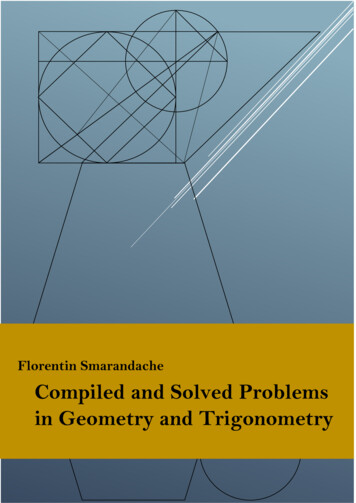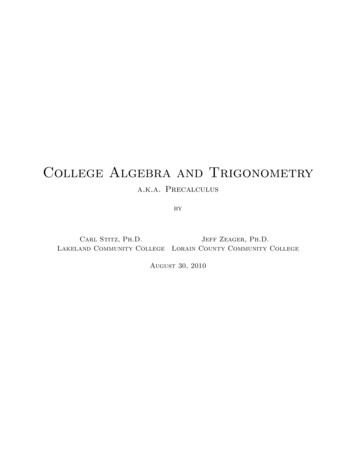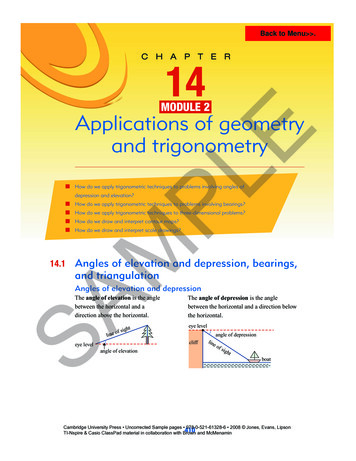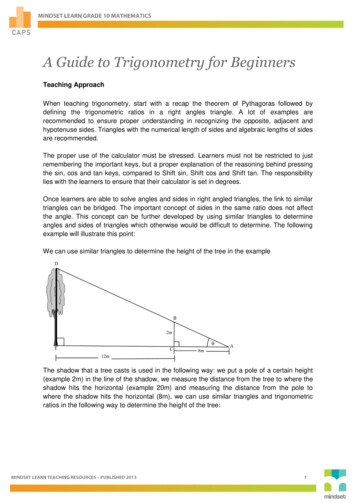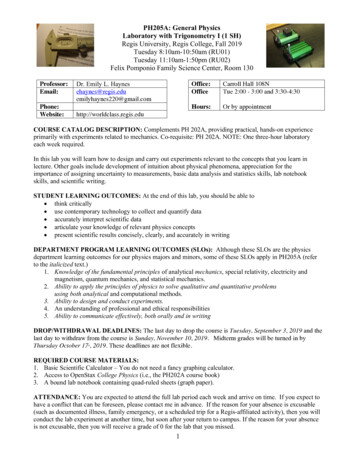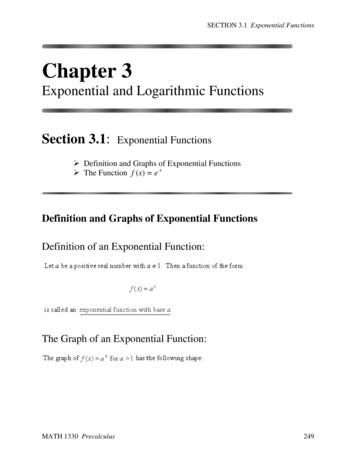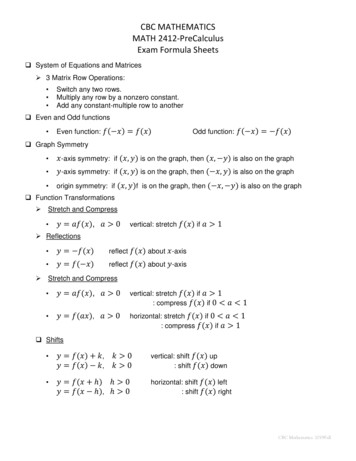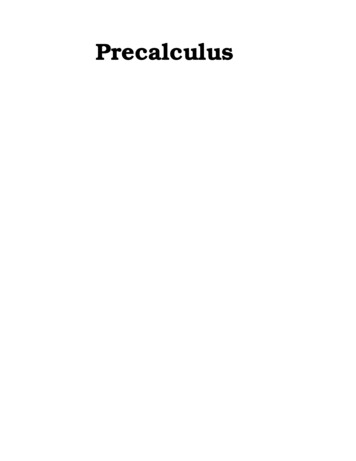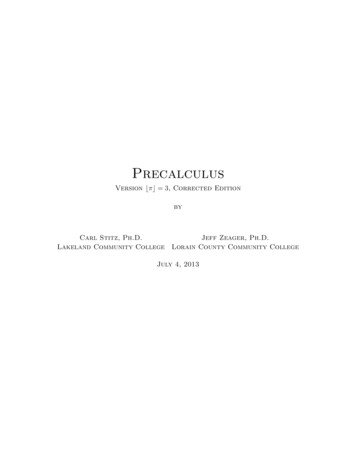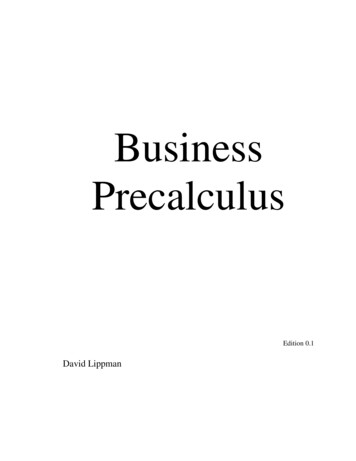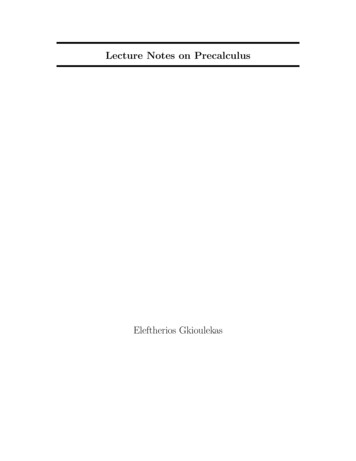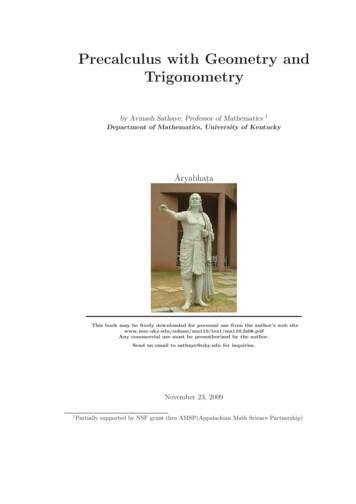
Transcription
Precalculus with Geometry andTrigonometryby Avinash Sathaye, Professor of Mathematics1Department of Mathematics, University of KentuckyĀryabhat.aThis book may be freely downloaded for personal use from the author’s web sitewww.msc.uky.edu/sohum/ma110/text/ma110 fa08.pdfAny commercial use must be preauthorized by the author.Send an email to sathaye@uky.edu for inquiries.November 23, 20091Partially supported by NSF grant thru AMSP(Appalachian Math Science Partnership)
iiIntroduction.This book on Precalculus with Geometry and Trigonometry should betreated as simply an enhanced version of our book on College Algebra. Most ofthe topics that appear here have already been discussed in the Algebra book andoften the text here is a verbatim copy of the text in the other book.We expect the student to already have a strong Algebraic background and thus thealgebraic techniques presented here are more a refresher course than a firstintroduction. We also expect the student to be heading for higher level mathematicscourses and try to supply the necessary connections and motivations for future use.Here is what is new in this book. In contrast with the Algebra book, we make a more extensive use of complexnumbers. We use Euler’s representation of complex numbers as well as theArgand diagrams extensively. Even though these are described and shown tobe useful, we do not yet have tools to prove these techniques properly. Theyshould be used as motivation and as an easy method to remember thetrigonometric results. We have supplied a brief introduction to matrices and determinants. The ideais to supply motivation for further study and a feeling for the Linear Algebra. In the appendix, we give a more formal introduction to the structure of realnumbers. While this is not necessary for calculations in this course, it is vitalfor understanding the finer concepts of Calculus which will be introduced inhigher courses. We have also included an appendix discussing summation of series - bothfinite and infinite, as well as a discussion of power series. While details ofconvergence are left out, this should generate familiarity with futuretechniques and a better feeling for the otherwise mysterious trigonometric andexponential functions.
Contents1 Review of Basic Tools.1.1 Underlying field of numbers. . . . . . . . . .1.1.1 Working with Complex Numbers. .1.2 Indeterminates, variables, parameters . . .1.3 Basics of Polynomials . . . . . . . . . . . .1.3.1 Rational functions. . . . . . . . . .1.4 Working with polynomials . . . . . . . . .1.5 Examples of polynomial operations. . . . .Example 1. Polynomial operations. . . .Example 2. Collecting coefficients. . . . .Example 3. Using algebra for arithmetic.Example 4. The Binomial Theorem. . .Example 5. Substituting in a polynomial.Example 6. Completing the square. . . .2 Solving linear equations.2.1 What is a solution? . . . . . . . . . . . . . . . . .2.2 One linear equation in one variable. . . . . . . . .2.3 Several linear equations in one variable. . . . . . .2.4 Two or more equations in two variables. . . . . .2.5 Several equations in several variables. . . . . . . .2.6 Solving linear equations efficiently. . . . . . . . .Example 1. Manipulation of equations. . . . . .Example 2. Cramer’s Rule. . . . . . . . . . . . .Example 3. Exceptions to Cramer’s Rule. . . . .Example 4. Cramer’s Rule with many variables.3 The division algorithm and applications3.1 Division algorithm in integers. . . . . . . . . . . . . . .Example 1. GCD calculation in Integers. . . . . . . .3.2 Āryabhat.a algorithm: Efficient Euclidean algorithm. . .Example 2. Kuttaka or Chinese Remainder 38394142.4545484952
2CONTENTS3.33.43.5Example 3. More Kuttaka problems. . . . . . . . . .Example 4. Disguised problems. . . . . . . . . . . . .Division algorithm in polynomials. . . . . . . . . . . .Repeated Division. . . . . . . . . . . . . . . . . . . . .The GCD and LCM of two polynomials. . . . . . . . .Example 5. Āryabhat.a algorithm for polynomials. . .Example 6. Efficient division by a linear polynomial. .Example 7. Division by a quadratic polynomial. . . .4 Introduction to analytic geometry.4.1 Coordinate systems. . . . . . . . . . . . . . . . . . .4.2 Geometry: Distance formulas. . . . . . . . . . . . . .4.2.1 Connection with complex numbers. . . . . . .4.3 Change of coordinates on a line. . . . . . . . . . . . .4.4 Change of coordinates in the plane. . . . . . . . . . .4.5 General change of coordinates. . . . . . . . . . . . . .4.5.1 Description of Isometies. . . . . . . . . . . . .4.5.2 Complex numbers and plane transformations.4.5.3 Examples of complex transformations. . . . .4.5.4 Examples of changes of coordinates: . . . . . .53545660626467697373757778798181828283.5 Equations of lines in the plane.5.1 Parametric equations of lines. . . . . . . . . . . . . . .Examples. Parametric equations of lines. . . . . . . .5.2 Meaning of the parameter t: . . . . . . . . . . . . . . .Examples. Special points on parametric lines. . . . . .5.3 Comparison with the usual equation of a line. . . . . .5.4 Examples of equations of lines. . . . . . . . . . . . . . .Example 1. Points equidistant from two given points.Example 2. Right angle triangles. . . . . . . . . . . .87. 87. 89. 91. 93. 95. 100. 102. 1036 Special study of Linear and Quadratic Polynomials.6.1 Linear Polynomials. . . . . . . . . . . . . . . . . . . .6.2 Factored Quadratic Polynomial. . . . . . . . . . . . .Interval notation. Intervals on real line. . . . . . .6.3 The General Quadratic Polynomial. . . . . . . . . . .6.4 Examples of Quadratic polynomials. . . . . . . . . .105105107107110113.1151151171201247 Functions7.1 Plane algebraic curves .7.2 What is a function? . . .7.3 Modeling a function. . .7.3.1 Inverse Functions.
3CONTENTS8 The8.18.28.38.4CircleCircle Basics. . . . . . . . . . . . . . . . . . . . . . . . . . . . . . . .Parametric form of a circle. . . . . . . . . . . . . . . . . . . . . . . .Application to Pythagorean Triples. . . . . . . . . . . . . . . . . . . .Pythagorean Triples. Generation of. . . . . . . . . . . . . . . . . .Examples of equations of a circle. . . . . . . . . . . . . . . . . . . . .Example 1. Intersection of two circles. . . . . . . . . . . . . . . . . .Example 1a. Complex intersection of two circles. . . . . . . . . . . .Example 2. Line joining through the intersection of two circles. . . .Example 3. Circle through three given points. . . . . . . . . . . . .Example 4. Exceptions to a circle through three points. . . . . . . .Example 5. Smallest circle with a given center meeting a given line.Example 6. Circle with a given center and tangent to a given line. .Example 7. The distance between a point and a line. . . . . . . . .Example 8. Half plane defined by a line. . . . . . . . . . . . . . . .9 Trigonometry9.1 Trigonometric parameterization of a circle. . . . . .Definition. Trigonometric Functions. . . . . . . . .9.2 Basic Formulas for the Trigonometric Functions. . .9.3 Connection with the usual Trigonometric Functions.9.4 Important formulas. . . . . . . . . . . . . . . . . . .9.5 Using trigonometry. . . . . . . . . . . . . . . . . . .9.6 Proofs I. . . . . . . . . . . . . . . . . . . . . . . . .9.7 Proofs II. . . . . . . . . . . . . . . . . . . . . . . .10 Looking closely at a function10.1 Introductory examples. . . . . . . . . . . . . . . . . . . . .Parabola. Analysis near its points. . . . . . . . . . . . . .Circle. Analysis near its points. . . . . . . . . . . . . . . .10.2 Analyzing a general curve y f (x) near a point (a, f (a)).10.3 The slope of the tangent, calculation of the derivative. . .10.4 Derivatives of more complicated functions. . . . . . . . . .10.5 General power and chain rules. . . . . . . . . . . . . . . .10.6 Using the derivatives for approximation. . . . . . . . . . .Linear Approximation. Examples. . . . . . . . . . . . 0220311 Root finding20911.1 Newton’s Method . . . . . . . . . . . . . . . . . . . . . . . . . . . . . 20911.2 Limitations of the Newton’s Method . . . . . . . . . . . . . . . . . . 211
412 Appendix 12.1 An analysis of 2 as a real number. . . . . . . . .12.2 Idea of a Real Number. . . . . . . . . . . . . . . .12.3 Summation of series. . . . . . . . . . . . . . . . .12.3.1 A basic formula. . . . . . . . . . . . . . .12.3.2 Using the basic formula. . . . . . . . . . .12.4 On the exponential and logarithmic functions. . .12.5 Infinite series and their use. . . . . . . . . . . . .12.6 Inverse functions by series . . . . . . . . . . . . .12.7 Decimal expansion of a Rational Number. . . . .12.8 Matrices and determinants: a quick 38241
Chapter 1Review of Basic Tools.1.1Underlying field of numbers.Mathematics may be described as the science of manipulating numbers.The process of using mathematics to analyze the physical universe often consists ofrepresenting events by a set of numbers, converting the laws of physical change intomathematical functions and equations and predicting or verifying the physicalevents by evaluating the functions or solving the equations.We begin by describing various types of numbers in use. During thousands of years,mathematics has developed many systems of numbers. Even when some of theseappear to be counterintuitive or artificial, they have proved to be increasingly usefulin developing advanced solution techniques.To be useful, our numbers must have a few fundamental properties.We should be able to perform the four basic operations of algebra: addition subtraction multiplication and division (except by 0)and produce well defined numbers as answers.Any set of numbers having all these properties is said to be a field of numbers (orconstants). Depending on our intended use, we work with different fields of numbers.Here is a description of fields of numbers that we typically use.1. Rational numbers Q . The most natural idea of numbers comes from simplecounting 1, 2, 3, · · · and these form the set of natural numbers often denotedby IN.1
2CHAPTER 1. REVIEW OF BASIC TOOLS.These are not yet good enough to make a field since subtraction like 2 5 isundefined. To fix the subtraction property, we can add in the zero 0 andnegative numbers. 1This produces the set of integers,ZZ {0, 1, 2, · · · }.These are still deficient because the division does not work. You cannot divide1 by 2 and get an integer back.where m, n are integersThe natural next step is to introduce the fractions mnand n 6 0. You probably remember the explanation in terms of picking upparts; thus 38 -th of a pizza is three of the eight slices of one pizza.We now have a natural field at hand, the so-called field of rational numbersQ {m m, n ZZ, n 6 0}n2. Real numbers ℜ. One familiar way of thinking of numbers is as decimalnumbers, say something like 2.34567 which is nothing but a rational number234567whose denominator is a power of 10. 2100,0001This simple sounding idea took several hundred years to develop and be accepted, because theidea of a negative count is hard to imagine. If we think of a number representing money owned,then a negative number can easily be thought of as money owed! The concept of negative numbersand zero was developed and expanded in India where a negative number is called r.n.a which alsomeans debt! The word used for a positive number, is similarly dhana which means wealth.The point is that even though the idea of certain numbers sounds unrealistic or impossible, oneshould keep an open mind and accept and use them as needed. They can be useful and somebodymay find a good interpretation for them some day.2Indeed, the number 10 can and is often replaced by other convenient numbers. The computerscientists often prefer 2 in place of 10, leading to the binary numbers, or they also use 8 or 16 inother contexts, leading to octal or hexadecimal numbers.In Number Theory, it is customary to replace 10 by some prime p and study the resulting p-adicnumbers.It is also possible and sometimes convenient to choose a product of suitable numbers, rather thanpower of a single one.It is interesting to consider numbers of the forma1 a2a3 ···2!3!where a1 is an arbitrary integer, while 0 a2 2, 0 a3 3 and so on. Thus, you can verify that:1712114 1 92! 3! 4! 5! 6!
1.1. UNDERLYING FIELD OF NUMBERS.3Thus, rational numbers whose denominators are powers of 10 are calleddecimal numbers.A calculator, especially a primitive one, deals exclusively with such numbers.One quickly realizes that even something as simple as 13 runs into problems ifwe insist on using only decimal numbers. It has successive approximations0.3, 0.33, 0.333, · · · but no finite decimal will ever give the exact value 13 .While this is somewhat disturbing, we do have the choice of writing 0.3 withthe understanding that it is the decimal number obtained by repeating thedigit 3 under the bar indefinitely.can be writ
Precalculus with Geometry and Trigonometry by Avinash Sathaye, Professor of Mathematics 1 Department of Mathematics, University of Kentucky Aryabhat .a This book may be freely downloaded for personal use from the author’s web siteFile Size: 1MBPage Count: 256
